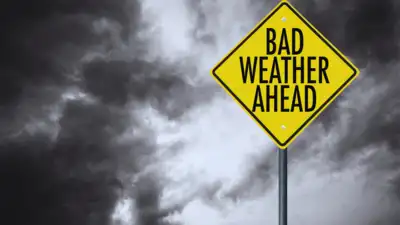The India Meteorological Department (IMD) regularly issues color-coded weather alerts during the monsoon season to inform the public and ensure preparedness for varying and potentially hazardous weather conditions.
These alerts are designed to provide timely and clear warnings about the intensity of rainfall, storms, and other adverse weather events. By categorizing alerts into different color codes, the IMD helps individuals, communities, and authorities assess the level of risk and take appropriate safety measures.
This system enhances awareness and enables more effective response strategies to safeguard lives, property, and infrastructure during the unpredictable monsoon period.
Read More: What IMD’s Red, Orange, Yellow, and Green Weather Alerts Actually Mean
Why Are Color Codes Used?
The IMD’s color-coded weather alert system is designed to empower individuals to make informed decisions during the monsoon season. By understanding the significance of each color code and its associated risks, citizens can better prepare for adverse weather conditions and minimize the impact of potential disruptions.
What Do the Colour Codes Mean?
The IMD’s colour-coded system categorizes weather risks into four levels: green, yellow, orange, and red. Each color indicates a progressively higher level of potential risk associated with the weather.
Green Alert (No Advisory): This signifies normal weather conditions, with minimal rainfall. During the monsoon season, a green alert indicates light, scattered showers or dry weather, posing little to no risk.
Yellow Alert (Be Aware): A yellow alert signals the possibility of moderate rainfall. While not severe, it could lead to localized flooding in low-lying areas or disrupt outdoor activities.
Orange Alert (Be Prepared): An orange alert is issued when heavy rainfall of 115.6 mm to 204.4 mm is expected within 24 hours. This level of rainfall heightens the risk of flooding in streets, streams, and low-lying areas, along with potential disruptions to transportation, power outages, and landslides.
Red Alert (Take Action): The most critical category, a red alert indicates extremely heavy rainfall exceeding 204.5 mm within 24 hours. This poses a serious threat to life and property, with widespread flooding, disruption of essential services, and the likelihood of evacuation orders.
Meaning of Red, Orange, Yellow, and Green Alerts
The IMD’s colour-coded weather alerts provide essential information regarding varying levels of weather risk. Each alert corresponds to a specific severity, helping individuals make informed decisions and take appropriate actions.
Red Alert: The highest level of warning, indicating extremely severe weather conditions. It signifies heavy rainfall exceeding 204.5 mm within 24 hours, posing a significant threat to life, property, and infrastructure. Widespread flooding, disruption of essential services, and evacuation measures are likely.
Orange Alert: Issued when heavy rainfall between 115.6 mm and 204.4 mm is expected within a 24-hour period. This alert signals an increased risk of flooding, transportation disruptions, and landslides, urging individuals to be prepared for adverse conditions.
Yellow Alert: This indicates the possibility of moderate rainfall, which may cause localized flooding or disrupt outdoor activities. While not severe, it serves as a precautionary measure, advising people to stay aware and take necessary precautions.
Green Alert: The lowest level, signifying normal weather conditions with minimal rainfall. During the monsoon, a green alert indicates light scattered showers or dry weather, posing no significant risk or disruption.
Frequently Asked Questions (FAQs)
What is the meaning of a Green Alert?
Green Alert indicates normal weather conditions with minimal rainfall. During the monsoon, it typically represents light scattered showers or dry weather, with no significant risks or disruptions expected.
What does a Yellow Alert signify?
Yellow Alert indicates moderate rainfall that may cause localized flooding or disrupt outdoor activities. While not severe, it advises people to be aware and take necessary precautions.
When is an Orange Alert issued, and what does it mean?
An Orange Alert is issued when heavy rainfall, ranging from 115.6 mm to 204.4 mm, is expected within 24 hours. It signals an increased risk of flooding, landslides, and transportation disruptions. People are advised to be prepared for adverse weather conditions.
What does a Red Alert mean, and what should I do?
Red Alert is the highest level of warning, indicating extremely heavy rainfall exceeding 204.5 mm within 24 hours. This poses a significant threat to life, property, and infrastructure, with a high likelihood of widespread flooding and disruptions. Immediate action, such as evacuation or staying indoors, is necessary.
How can I stay informed about these alerts?
The IMD provides updates via their official website, mobile apps, and through media channels. It’s essential to monitor weather alerts regularly during the monsoon season to stay informed.
What actions should I take during a Red Alert?
During a Red Alert, take immediate safety measures such as evacuating if instructed, staying indoors, avoiding travel, and securing valuables. Follow local authorities’ guidelines and stay informed through reliable sources.
Conclusion:
Understanding the IMD’s color-coded weather alerts is essential for staying informed and prepared during the monsoon season. Each alert—Green, Yellow, Orange, and Red—provides crucial information about potential weather risks, helping individuals make timely decisions to ensure their safety. While Green alerts signal normal conditions, Yellow, Orange, and Red alerts progressively highlight the severity of potential weather disruptions, with Red representing the highest level of danger.

